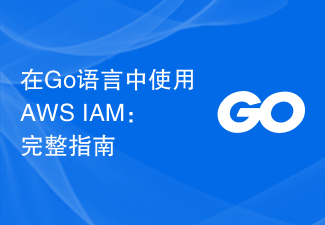This article mainly introduces the Yaf framework installation guide, which has a certain reference value. Now I share it with everyone. Friends in need can refer to it
Speaking of the PHP framework, many people The impression remains on a code package based on MVC's various functional combinations implemented by PHP. Very few people know that C language can also write PHP frameworks, and the speed is more than 10 times faster than frameworks written in PHP.
Yaf is a PHP framework written in C language. It runs the framework as a PHP extension. Only the core functions of MVC are implemented: routing and MVC. The Yaf kernel is streamlined and stable enough, so there are almost no operational problems. Risks are controllable and performance is excellent. Of course, because it is simple, you need to implement operations such as DB closure and Session expansion.
As a PHP programmer, I should be familiar with the framework written by Asia’s number one programmer: Brother Niao, so what are its advantages?
The PHP framework developed in C language brings almost no additional performance overhead compared to native PHP.
-
All framework classes do not need to be compiled. They are loaded when PHP starts and are resident in memory.
Shorter memory turnover cycle, improves memory utilization and reduces memory usage Occupancy rate.
Flexible automatic loading. Supports both global and local loading rules to facilitate class library sharing.
High-performance view Engine.
A highly flexible and extensible framework that supports custom view engines, plug-ins, custom routing, etc.
Build a variety of routes that are compatible with various currently common routing protocols.
Powerful and highly flexible configuration file support. It also supports caching configuration files to avoid complex configuration structures. Performance loss.
In the framework itself, dangerous operating habits are prohibited.
Faster execution speed, less Memory usage.
Framework installation:
1:Framework installation
Yaf extension homepage:http://pecl. php.net/package/yaf
$ wget http://pecl.php.net/get/yaf-3.0.7.tgz $ tar -zxvf yaf-3.0.7.tgz $ cd yaf-3.0.7 $ /path/to/phpize $./configure --with-php-config=/path/to/php-config $ make && make test && make install
tip:
When executing the compilation command /path/to/phpize, the following error may occur:
Configuring for: PHP Api Version: 20151012 Zend Module Api No: 20151012 Zend Extension Api No: 320151012 Cannot find autoconf. Please check your autoconf installation and the $PHP_AUTOCONF environment variable. Then, rerun this script.

You can refer to: https://blog.csdn.net/alen_xiaoxin/article/details/80255766 to find solutions.
After compiling and generating the extension, modify php.ini and add the following configuration at the end of the php.ini file:
[yaf] yaf.use_namespace = 0 yaf.environ = 'product' yaf.cache_config = 0 yaf.name_suffix = 1 yaf.lowcase_path = 1 extension = yaf.so
After adding it, you can check whether there is a yaf extension in phpinfo.
Configuration instructions:
yaf.user_namespace is 1 to enable namespace mode. 0 off.
yaf.environ is the environment configuration read by Yaf by default.
yaf.cache_config Whether to cache project configuration.
yaf.name_suffix Enable suffix. After it is 1, the class name will be loaded in XxxModel.php, XxxController.php mode.
yaf.lowcase_path The directory part in the path information will be converted to lowercase.
2. Create the first Yaf project
There are two ways to create it:
-
Create the directory manually
Use the command line provided by Yaf to generate the directory
第二种方法可自行到:https://github.com/laruence/php-yaf,下载源码,因为 Yaf 提供的命令工具没有随 Yaf 源码一起,在该项目下面有一个tools文件夹,里面就是命令行工具。
一个典型的目录结构:
<p style="margin-bottom: 7px;">+ public<br/> |- index.php //入口文件<br/> |- .htaccess //重写规则 <br/> |+ css<br/> |+ img<br/> |+ js<br/>+ conf<br/> |- application.ini //配置文件 <br/>+ application<br/> |+ controllers<br/> |- Index.php //默认控制器<br/> |+ views <br/> |+ index //控制器<br/> |- index.phtml //默认视图<br/> |+ modules //其他模块<br/> |+ library //本地类库<br/> |+ models //model目录<br/> |+ plugins //插件目录<br/></p>
入口文件:
入口文件是所有请求的入口, 一般都借助于rewrite规则, 把所有的请求都重定向到这个入口文件。
一个经典的入口文件piublic/index.php:
<?php
define("APP_PATH", realpath(dirname(__FILE__) . '/../')); /* 指向public的上一级 */
$app = new Yaf_Application(APP_PATH . "/conf/application.ini");
$app->run();重写规则:
Apache的Rewrite (httpd.conf):
#.htaccess, 当然也可以写在httpd.conf
RewriteEngine On
RewriteCond %{REQUEST_FILENAME} !-f
RewriteRule .* index.phpNginx的Rewrite (nginx.conf):
server {
listen ****;
server_name domain.com;
root document_root;
index index.php index.html index.htm;
if (!-e $request_filename) {
rewrite ^/(.*) /index.php/$1 last;
}
}配置文件:
在Yaf中, 配置文件支持继承, 支持分节. 并对PHP的常量进行支持. 你不用担心配置文件太大造成解析性能问题, 因为Yaf会在第一个运行的时候载入配置文件, 把格式化后的内容保持在内存中. 直到配置文件有了修改, 才会再次载入。
一个简单的配置文件application/application.ini:
[product] ;支持直接写PHP中的已定义常量 application.directory=APP_PATH "/application/"
控制器:
在Yaf中, 默认的模块/控制器/动作, 都是以Index命名的, 当然,这是可通过配置文件修改的.
对于默认模块, 控制器的目录是在application目录下的controllers目录下, Action的命名规则是"名字+Action"
默认控制器application/controllers/Index.php
<?php
class IndexController extends Yaf_Controller_Abstract {
public function indexAction() {//默认Action
$this->getView()->assign("content", "Hello World");
}
}
?>视图文件:
Yaf支持简单的视图引擎, 并且支持用户自定义自己的视图引擎, 比如Smarty。
对于默认模块, 视图文件的路径是在application目录下的views目录中以小写的action名的目录中。
一个默认Action的视图application/views/index/index.phtml
<html> <head> <title>Hello World</title> </head> <body> <?php echo $content;?> </body> </html>
运行:
在浏览器输入你服务器配置的域名即可:
http://www.yourhostname.com/application/index.php
我是在本地配置的直接把端口指向public目录,所以直接输入:localhost:8081,即可看到
注意:
如果看不到Hello world,那么请到服务器查看PHP的错误日志,找出问题在哪里。
The above is the detailed content of Yaf framework installation guide. For more information, please follow other related articles on the PHP Chinese website!
 在Go语言中使用Elastic Stack:完整指南Jun 17, 2023 am 10:42 AM
在Go语言中使用Elastic Stack:完整指南Jun 17, 2023 am 10:42 AM在Go语言中使用ElasticStack:完整指南ElasticStack是一个开源工具集,它为搜索、分析和可视化大量数据提供了强大的支持。该工具集由四个主要组件组成:Elasticsearch、Logstash、Kibana和Beats。其中,Elasticsearch是一个分布式的搜索和分析引擎,能够快速地执行搜索、分析和聚合操作。Logstash是
 在Go语言中使用AWS S3:完整指南Jun 17, 2023 am 08:21 AM
在Go语言中使用AWS S3:完整指南Jun 17, 2023 am 08:21 AM近年来,随着云计算技术的发展,许多企业开始转向使用云存储服务来存储和管理自己的数据。其中,AWSS3(AmazonWebServicesSimpleStorageService)是一种备受欢迎的选择。作为AWS的核心服务之一,S3提供了高可用性、高性能、可扩展和安全的存储服务。在这篇文章中,我们将深入探讨如何在Go语言中使用AWSS3。安装AW
 PHP中的安全审计指南Jun 11, 2023 pm 02:59 PM
PHP中的安全审计指南Jun 11, 2023 pm 02:59 PM随着Web应用程序的日益普及,安全审计也变得越来越重要。PHP是一种广泛使用的编程语言,也是很多Web应用程序的基础。本文将介绍PHP中的安全审计指南,以帮助开发人员编写更加安全的Web应用程序。输入验证输入验证是Web应用程序中最基本的安全特性之一。虽然PHP提供了许多内置函数来对输入进行过滤和验证,但这些函数并不能完全保证输入的安全性。因此,开发人员需要
 在Go语言中使用AWS SDK:完整指南Jun 17, 2023 am 09:40 AM
在Go语言中使用AWS SDK:完整指南Jun 17, 2023 am 09:40 AMAWS(AmazonWebServices)是一家全球领先的云计算提供商,为企业和个人提供各种云计算服务。随着云计算技术的发展,越来越多的开发者开始使用AWS来进行开发、测试和部署他们的应用程序。Go语言是一门非常流行的编程语言,尤其适合构建高性能和可扩展的云原生应用程序。AWS提供了适用于Go语言的SDK(SoftwareDevelopmentKi
![如何使用 wmic 快速列出所有 Windows 进程 [教程]](https://img.php.cn/upload/article/000/887/227/168569000461539.jpg) 如何使用 wmic 快速列出所有 Windows 进程 [教程]Jun 02, 2023 pm 03:13 PM
如何使用 wmic 快速列出所有 Windows 进程 [教程]Jun 02, 2023 pm 03:13 PM当您在处理各种重要项目并且性能是关键字时,必须准确了解后台运行的进程。特别是如果上述一个或多个过程影响您当前的工作,或者您可以只使用额外的果汁。准确地找出您的设备仍在后台运行的内容非常容易。您可以使用wmic工具在几秒钟内获得所需的所有信息。怎么样,你问?我们将在本文中向您展示这一点,因此您可以方便地获得这些信息以供将来参考。如何使用wmic了解后台进程?实际上,您可以在命令提示符窗口中输入许多有用的命令,前提是您以管理员权限打开它,这些命令可以提供宝贵的信息。了解后台进程以及收集系统信息(BI
 PHP中的ERP系统开发指南May 21, 2023 am 08:22 AM
PHP中的ERP系统开发指南May 21, 2023 am 08:22 AM随着现代企业的发展,ERP系统的重要性也越来越凸显出来。ERP系统可以帮助企业集成和管理计划、客户关系、供应链、人力资源等方面的数据和业务流程。PHP作为一种流行的编程语言,也可以用于开发ERP系统。在本文中,我们将分享一些PHP中的ERP系统开发指南。确定ERP系统的需求在开始开发ERP系统之前,您需要确定自己的ERP系统所需要的功能。根据你的企业的运营方
 PHP中的音频操作指南May 20, 2023 pm 09:42 PM
PHP中的音频操作指南May 20, 2023 pm 09:42 PMPHP作为一种广泛使用的服务器端语言,在许多Web应用程序中扮演着重要的角色。音频处理是一个很常见的需求,例如音乐网站和音频产品销售网站等。在本文中,将为读者介绍如何在PHP中操作音频文件。一、了解音频格式在PHP中操作音频文件前,需要先了解音频文件格式。常见的音频格式有MP3、WAV、OGG、FLAC等。不同的格式有不同的音频编码算法和数据格式。例如,MP
 在Go语言中使用AWS IAM:完整指南Jun 17, 2023 pm 03:39 PM
在Go语言中使用AWS IAM:完整指南Jun 17, 2023 pm 03:39 PMAWS(AmazonWebServices)作为云计算业界的领头羊,提供了方便而强大的云计算服务,使得企业可以轻松地构建和管理自己的IT基础设施,并获得更好的可扩展性、灵活性和低成本。而IAM(IdentityandAccessManagement)是AWS中的重要服务之一,负责管理用户(包括人员、应用、服务等)的身份和访问权限,保障AWS资源的安


Hot AI Tools

Undresser.AI Undress
AI-powered app for creating realistic nude photos

AI Clothes Remover
Online AI tool for removing clothes from photos.

Undress AI Tool
Undress images for free

Clothoff.io
AI clothes remover

AI Hentai Generator
Generate AI Hentai for free.

Hot Article

Hot Tools

SublimeText3 English version
Recommended: Win version, supports code prompts!

DVWA
Damn Vulnerable Web App (DVWA) is a PHP/MySQL web application that is very vulnerable. Its main goals are to be an aid for security professionals to test their skills and tools in a legal environment, to help web developers better understand the process of securing web applications, and to help teachers/students teach/learn in a classroom environment Web application security. The goal of DVWA is to practice some of the most common web vulnerabilities through a simple and straightforward interface, with varying degrees of difficulty. Please note that this software

mPDF
mPDF is a PHP library that can generate PDF files from UTF-8 encoded HTML. The original author, Ian Back, wrote mPDF to output PDF files "on the fly" from his website and handle different languages. It is slower than original scripts like HTML2FPDF and produces larger files when using Unicode fonts, but supports CSS styles etc. and has a lot of enhancements. Supports almost all languages, including RTL (Arabic and Hebrew) and CJK (Chinese, Japanese and Korean). Supports nested block-level elements (such as P, DIV),

Notepad++7.3.1
Easy-to-use and free code editor

PhpStorm Mac version
The latest (2018.2.1) professional PHP integrated development tool







